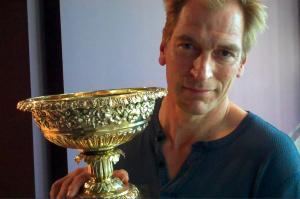Actor Julian Sands is a long-time friend to LACMA and—currently--a lender to the Lucknow exhibition. We asked him about collecting, and about the Lucknow tureen, one of his treasures.

Julian Sands, with another piece that came to LACMA from his collection: a Paul Storr centerpiece
What and why do you collect?
I don’t think of myself as a collector. I spend a lot of time on mountains doing marathons in remote places where you are carrying with you the minimum you need to exist: a tent, a bed, some fuel, some food. That’s your world. I acquire things with the ferocity of a pirate, but like a pirate I just like to dig a hole in the sand and drop it in and head off for more. It’s an insatiable greed, foiled by this Trappist like renunciation.
Tell us your impressions of the exhibition India's Fabled City: The Art of Courtly Lucknow?
The show reveals Lucknow as this jewel of a place. In local terms, what would it be? San Francisco with downtown New York and New Orleans all rolled up into one! And fabled, with its poets and painters and craftsmen and glamorous courtesans. It was a tremendous meeting point of east and west.
Stephen Markel has been putting this exhibition together for twelve or fifteen years. He has cast his net wide to bring together these great treasures. His passion for his subject is fabulous.

The Lucknow Tureen
Tell us about the Lucknow Tureen, now on view at LACMA in the Lucknow exhibition?
It has sculptural presence, immense beauty and grace. The shape is classically Mughal. But there are these lions which look exactly like an English lion.
Claude Martin, the great nabob of Lucknow, who was drummed out eventually and fled back to England, built a magnificent building—which is, today, called La Martiniere—in Lucknow. There are motifs on the bowl that you’ll find in the architecture of the building. In particular, the lions are very much like the lions you’ll flanking the Martiniere. So there is every reason to suppose the piece was commissioned as part of a service for the Martiniere.
I like to think somewhere there is a great ladle. But a lot of these things got melted down. The Indian tradition wasn’t to pass things on to keep so much as to pass things on to melt down and people remade things in their own style.

The Lucknow Tureen, detail
How did you come across the piece?
I found the piece through a friend of mine, who is a great scholar of colonial silver: Wynyard Wilkinson. I’ve known him since I was at school. For a long time, I coveted it.
Really great objects have tremendous power and energy. There is something of the nervous system of their creator, the man or woman who chiseled or cast or painted or drew or fabricated the object.
I don’t set out to collect anything for sake of a collection. I get interested in a form, a medium, a type of work. So you go looking for things. And then when you find something you may have been seeking, there’s a release, almost like an Arthurian knight. You are released from the challenge.
What do you like to see when you visit the museum?
All my life I have taken such pleasure from museums.
LACMA, in particular, has amazing space and such great light – you feel that it’s an organic, ongoing, 21st century, vibrating beacon of forward-looking culture bringing the past into the present. There’s a great fusion of possibilities here.
When I’m here at LACMA I usually visit the paintings and sculpture in the Modern galleries – the quality and balance is superb. The presentation of sculpture is wonderful. I love the great Tony Smith, and going in the new Resnick Pavillion, a place of beauty and an architectural wonder.
India’s Fabled City: The Art of Courtly Lucknow is on view through February 27th, 2011. View a slideshow of 19th century photographs of courtly Lucknow at lacma.org.
Amy Heibel



